I am totally convinced that the Warren Commission was correct in its findings, ... there is so much evidence in the Warren Report and the supporting volumes of evidence that there is no doubt there was one lone shooter who fired three bullets from a perfect vantage point and all three shots found their mark.It's generally agreed, especially by anyone who believes that John F. Kennedy was killed by a bullet from behind, that if Secret Service agents were riding the rear bumper steps on JFK's limo, JFK would probably not have been assassinated. Secret Service Agent Lynn Meredith said the number one reason JFK was killed was, "No Secret Service agents were riding on the rear of the limousine." Jim Bishop author of The Day Kennedy Was Shot wrote, "No one wanted to weigh the possibilities that, if a Secret Service man had been on the left [sic] rear bumper going down Elm Street, it would have been difficult to hit President Kennedy."
- Gerald Blaine in The Miami New Times
Most of the people writing conspiracy theory books don't make any sense to me. If they are not going to deal with facts, then I don't want anything to do with it.
Clint Hill on C-SPAN with Gerald Blaine at 16:00
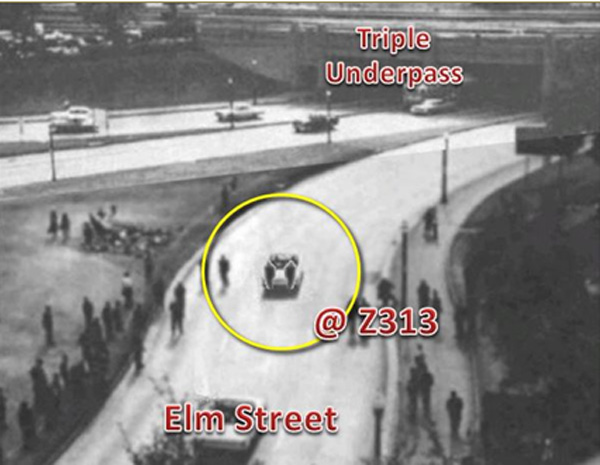
So, the big question is why were there no agents on the rear bumpers?
There is a segment from the ten-hour video documentary Evidence of Revision where Special Agents (SA) Clint Hill and Don Lawton are called off while running near the rear bumpers by Assistant Special Agent In Charge (ASAIC) Emory Roberts who stands up in the follow-up car. The video captures the start of the Dallas motorcade at Love Field not long after Air Force One landed. This can also be seen in this YouTube video: "JFK assassination - Secret Service Stand down". This video has almost five million views.
If you watch this video now for the first time, watch it with the sound off, so as not to be influenced by the bias of the narrator. What did you think? Did everything seem hunky dory? What is your reaction to Lawton's three shrugs? Is his shrugging in puzzlement or maybe only playful banter?
While Emory Roberts stands to wave off Don Lawton, SA Paul Landis on the right rear running board of the follow-up car moves into the car to seemingly make room for Don Lawton. The reason why Landis gets in the car is never stated. But Lawton remains at Love Field with four other agents (Henry Rybka, Roger Warner, William Patterson and John O'Leary) as well as members of the Dallas police, "to effect security for the president's departure," as Lawton described it. If Lawton's assignment was to remain at Love Field, why was he running with the motorcade in the first place?
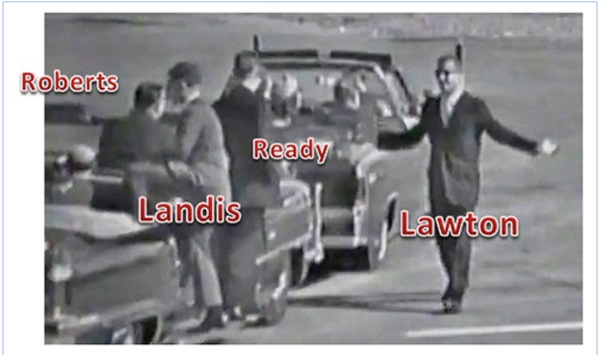
at the rear bumper of JFK’s limo by Emory Roberts.
As an aside: Landis, Bennett and Ready (all on the follow-up car) were up late at The Cellar Door in Fort Worth the night before. Landis stayed until 5:00 AM. He went on duty at 8:00 AM. The Cellar served no alcohol and they only drank fruit juice [The Kennedy Detail, page 177] or pure Everclear [Who's Who In The JFK Assassination, page 239]. Vice-President Lyndon Johnson, coincidentally, may have made his way to The Cellar Door that night as well, according to his mistress, Madeleine Brown. [Texas in the Morning, page 166] I assume he was there for the fruit juice too.
The above video clip begs the question: would Don Lawton have ridden that rear bumper if he was not called away? It's an interesting question, because just four days prior to that fateful day in Dallas, Don Lawton rode the same right rear bumper of JFK's limousine as it travelled 28 miles around the streets of Tampa, Florida.
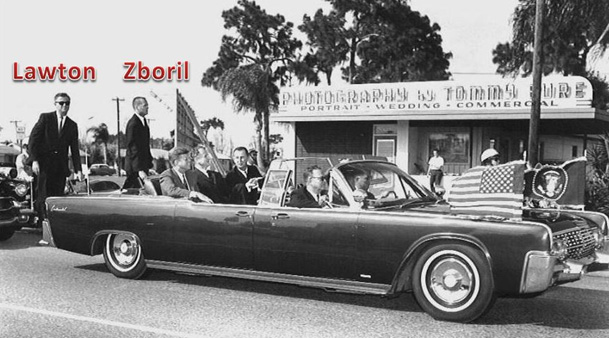
Now on that fateful day in Dallas, SA Clint Hill does ride the left rear bumper every now and then. Clint's duty is not to JFK but to Jacqueline Kennedy, to whom he is assigned, and he is there at her request. Clint Hill as well as Paul Landis are not part of the Kennedy detail, but the First Lady Detail: Jackie Kennedy. Unlike Lawton and Zboril in Tampa, the photos of Clint show him always squatting on the rear bumper step.
We can see Clint riding the right rear bumper in these pictures:
But there are no pictures of anyone riding the bumper behind JFK. That is because no one does. Not once.
Clint Hill offers a reason why he is riding the rear bumper in Florida. You may be able to see in the last photo that the crowds have spilled onto the streets and Bill Greer (the driver of JFK's limo) no longer drives down the middle of Main Street, but is on the left side of the road. He wants to leave more space between JFK and the crowd than between Jackie and the crowd. Greer's primary duty is to protect the president, not his wife. Clint notices this and wants to give Jackie some added protection, so he leaves the running board and rides the rear bumper step on her side. Otherwise, Clint's position was on the running board on the follow-up car, like the three other agents.
Clint Hill says this in this statement he prepared only eight days after the assassination:
But Clint offers no reason for why he did not just stay on the bumper. At least not yet.
JFK, Floyd Boring, Gerald Blaine and Those "Ivy League Charlatans"
But why were there two Special Agents on the rear bumper during the entire trip through Tampa just four days prior to Dallas, yet only Clint is occasionally behind Jackie and no one behind JFK through Dallas? What happened to change a long-standing Secret Service protocol in only four days?
The first hint is to be found in a 73-page document produced by the Secret Service less than 4 weeks after the assassination. One passage in particular shifts blame away from the Secret Service and onto JFK himself:
"There are special steps and handles built into the President's car at the two rear corners especially so that agents riding the front running board of the Presidential follow-up car can ride there; the President had frequently stated that he did not wish to have the agents riding on these steps during a motorcade and had repeated this wish only a few days previously to agents assigned to him in Tampa. (In Dallas SA Hill, who had been assigned to Mrs. Kennedy and had not been in Tampa with the President, occasionally rode on the left rear step. Agent Ready, who was aware that the President had specifically stated his objection to agents riding on the steps, did not ride the step in Dallas.)"Clint Hill backs up this Secret Service Report in his testimony to the Warren Commission a few months later in early March of 1964:
Report of the U.S. Secret Service on the Assassination of the President Kennedy - page 20
Mr. SPECTER. Now, had there been any instruction or comment about your performance of that type of a duty with respect to anything that President Kennedy himself had said in the period immediately preceding the trip to Texas?Four days before JFK's assassination, Secret Agent Gerald Blaine was the advance man in Tampa and he was also in the car ahead of JFK's limo in the Tampa motorcade. Gerald has written the best seller The Kennedy Detail, published in 2010, an account of his five years as a Secret Service Special Agent at the White House from 1959 to 1964. The Kennedy Detail, by the way, is also being made into a movie scheduled for release in 2014.
Mr. HILL. Yes, sir; there was. The preceding Monday, the President was on a trip in Tampa, Fla., and he requested that the agents not ride on either of those two steps.
Mr. SPECTER. And to whom did the President make that request?
Mr. HILL. Assistant Special Agent in Charge [Floyd] Boring.
Mr. SPECTER. And Special Agent Boring informed you of that instruction by President Kennedy?
Mr. HILL. Yes, sir; he did.
Mr. SPECTER. Did he make it a point to inform other special agents of that same instruction?
Mr. HILL. I believe that he did, sir.
Mr. SPECTER. And, as a result of what President Kennedy said to him, did he instruct you to observe that Presidential admonition?
Mr. HILL. Yes, sir.
Mr. SPECTER. How, if at all, did that instruction of President Kennedy affect your action and--your action in safeguarding him on this trip to Dallas?
Mr. HILL. We did not ride on the rear portions of the automobile. I did on those four occasions because the motorcycles had to drop back and there was no protection on the left-hand side of the car.
Clint Hill's Testimony to the Warren Commission: 2H132
Blaine tells us what happened in a 2010 interview on C-SPAN :
While the motorcade is passing through an area of Tampa with few people, JFK tells ASAIC Floyd Boring, "Floyd, tell the Ivy League Charlatans to get off the car." Floyd in turn, radios Blaine in the lead car up ahead, "The President wants the Ivy League Charlatans off the car." As soon as the motorcade slows enough the two bumper riders retreated to the follow-up car.Several times in his book, Blaine claims that JFK told agents a number of times to get off the limo in Tampa and referred to them as "Ivy League Charlatans":
JFK told Floyd, "if I didn't get out and shake hands with the people, I couldn't get elected dog catcher." He said for this trip and the trip down in Texas, "I don't want the agents riding on the back of the car."
Gerald Blaine and Clint Hill on C-SPAN, at 06:00 and 07:30
"JFK was enjoying the crowds and was standing up and holding on to the wide roll bar that had hand slots for just that purpose. He suddenly bent down because of the motorcycle noise, so he could speak into Floyd's ear. "Floyd, have the Ivy League Charlatans drop back to the follow-up car."The Secret Service wanted agents riding the bumper
Floyd had known this was coming. He was actually surprised the president had let Lawton and Zboril stay back there for so long. The whole purpose of the motorcade was political and Floyd knew that Kennedy did not want to be shielded from the public.
Floyd grabbed the radio mike and said, "Halfback, Lancer request the Ivy League charlatans drop back to your location."
In the three years he'd been with JFK, he'd never heard the president call the agents off the back of the car in the middle of a motorcade. Apparently politics was trumping the Secret Service.
[The Kennedy Detail, page 148]
When the motorcade arrived at the National Guard armory, President Kennedy reiterated to Floyd Boring that he did not want the agents standing on the rear of the car.
"It's excessive, Floyd," he said. "And it's giving the wrong impression to the people. Tell them to stay on the follow-up car. We've go an election coming up. The whole point is for me to be accessible to the people." The president didn't seem angry, but his message came through loud and clear.
For the last two legs of the motorcade, as they stood on the running boards of the follow-up car, Zboril and Lawton were at a heightened state of alertness. They were much too far from the president...
[The Kennedy Detail, page 149]
"What? Didn't you hear? In Tampa the Boss told Floyd that he didn't want agents on the back of the car. What happened?"
[SA] Pontius looked at [SA] DeFreese in amazement. "Really? I've never hear the president say anything about agents on the back of the car. What happened?"
"I'm not sure," DeFreese answered with a shrug. "Blaine had the agents posted on the back of the car and in the middle of the Tampa ride, the Boss said something to Floyd like, 'Keep the Ivy League charlatans off the back of the car.' He didn't want the agents crowding him, and from what I understood, the directive was to be followed through here in Texas, too."
[SA Pontius remarking to SAIC Jerry Behn over the phone:] "That's right. The order came from the Boss himself. He wanted the agents off the back of the car in order for the people to get an unobstructed view. He doesn't want to appear like he's not accessible."
[The Kennedy Detail, page 162]
Blaine knew Emory was concerned about staffing the motorcade, but of course he wouldn't say anything. The president's order to "keep the Ivy League charlatans off the back of the car" in Tampa, four days earlier, had been circulated throughout the detail and Emory, despite his strong disagreement, had no choice but to comply. For Jerry, the comment still stung because it had been at his urging that the two agents were positioned on the back of the presidential limousine.
[The Kennedy Detail, page 183]
Floyd recounted how Agents Chuck Zboril and Don Lawton were posted on the rear steps of the limousine throughout much of the motorcade; the heavy crowds; the small group of protesters.
"Everything was going along fine, but I noticed the president continually glancing back at the agents standing behind him," Floyd said. "And then he made an unusual request."
"And what exactly did he say? Rowley asked.
"He was standing up and he leaned toward me ... I, of course, was sitting in the front passenger seat, while Bill Greer was driving," Floyd said. "So, he leaned toward me and said, 'Floyd, have the Ivy League Charlatans drop back to the follow-up car.' "
The statement made Rowley's mouth turn up in a slight smile, even as he blinked back a tear. He could hear the president saying that. Ivy League charlatans. God, he was going to miss JFK.
"Now, when he made this unusual request, was he angry? And what did you take it to mean?"
"No, no" Floyd began. "I didn't get the impression that he was angry. To be honest, I wasn't exactly sure what he meant by 'Ivy League charlatans, but I sure as hell knew what he meant when he said to have them drop back to the follow-up car. I knew he felt like they were hovering a bit too close. And this being a political trip and all, I think he was very conscious of the appearance."
[The Kennedy Detail, page 286]
"Okay, so the president asked you to have the agents drop back to the follow-up car, and what did you do then, Floyd?"
"Well, sir, I got on the radio and radioed back to Emory, who was in the front seat of the follow-up car."
"And what did you tell Emory?"
"I repeated what the president had said to me," Floyd said with a slight laugh. "I repeated it exactly because I thought Emory would get a kick out of the president's phrase. I said, 'Halfback, Lancer request the Ivy League Charlatans drop back to your location.' "
Rowley looked at Emory Roberts. "Is that correct, Emory?"
"Yes, sir. I did. I heard exactly what Floyd just told you."
[The Kennedy Detail, page 287]
"Let me jump in here, sir, if I may," said Floyd Boring. "When we arrived at our destination [in Tampa] after this incident, the president pulled me aside and told me that this was a political trip and that he felt like the agents were being excessive in their coverage. He told me that the same goes for the upcoming trips to Texas and would I please relay his request to the other supervisors, which I did upon returning to Washington."
[The Kennedy Detail, page 288]
Gerald Blaine also makes it clear that, in distinct opposition to JFK's desire, the Secret Service wanted agents riding the rear bumper in both Tampa and Dallas. Gerald Blaine emphasizes this in various passages in his book:
[Gerald is in charge of planning the Tampa motorcade. He writes about this trip:]Blaine also retells the story on C-SPAN:
--- the only way to have a chance at protecting the president against a shooter from a tall building would be to have agents posted on the back of the car.
[The Kennedy Detail, page 74]
[SA Winston Lawson was advance man for JFK's Dallas visit. While driving the Dallas motorcade route with SAIC Forrest Sorrels in preparation for the big day, Gerald writes:]
... as he [ Win Lawson ] looked up again at all the open windows. He was concerned about the exposure. Fortunately they'd have SS100X in Dallas, which had the rear steps and handholds so two agents could be perched directly behind the president and could react quickly. He'd be sure to tell Roy Kellerman, the Special Agent in Charge for the Texas trip, that when the motorcade was driving through downtown, agents would need to be on the back of the car.
[The Kennedy Detail, pages 100 to 101]
Even with the tremendous cooperation of the Tampa law enforcement and the lack of any currently known Cuban threat, Blaine was still concerned about the president's unprecedented exposure in the twenty-eight-mile motorcade. He'd wrestled with various ideas but had come up with only one solution that would put his mind at ease. He was going to strongly recommend that two Secret Service agents be posted on the back of the presidents' limousine for the duration of the motorcade.
[The Kennedy Detail, page 139]
[Gerald writes about a phone conversation he had with his boss Emory Roberts before the Tampa motorcade: ]
"Hey, Jer [Gerald] what's up? Everything okay in Tampa?"
"Well, there's something I wanted to run by you and Floyd."
"Go ahead," Emory said.
"It's about the motorcade. Yeager and I have been discussing it, and we feel strongly that two agents need to be assigned to the back of the Boss's car for the entire route?"
"Really? What's going on there?"
Four stops, a chopper ride, thirty miles of motorcade, and a lot of people. There have been some petitions for demonstrations by a couple of Cuban groups, which makes me a little concerned as well."
"Okay, I get the picture. Sounds like taking some extra precaution would be reasonable," Emory replied.
[A little later Gerald says:]
"If we stick Zboril and Lawton on the back of the president's car, they won't wear themselves out running back and forth to the follow-up:
[The Kennedy Detail, page 142]
[In a conversation between Emory Roberts and Floyd Boring, Blaine writes:]
"But there was something he wanted to run by you," Emory said. "You know the motorcade is close to thirty miles long. Blaine feels strongly that we need to assign agents to the back of the president's limousine."
"For the whole route?" Floyd asked.
"Yes. That's what he's recommending."
"I have no objections, but I don't know what the president is going to say about it...."
...."Well, you know as well as I do that unless there's an imminent or obvious threat, the president doesn't like us hovering so close."
[The Kennedy Detail, pages 144 to 145]
"I had conducted the advance in Tampa Florida." "I had a very good record of what happened in Tampa Florida." [He remarks that in the month prior to the 28 mile Tampa motorcade the White House detail had lost eleven agents and he had only one experienced agent available to rely on in Tampa. With this in mind, Blaine said to ASAIC Floyd Boring, (at 5:44) ] "Floyd, we are going to wear these guys out, so let's put them on the back of the car and approach it that way." Floyd responds with, "I don't know whether the boss [JFK] is going to buy that or not, but let's go with it."What was he thinking?
Gerald Blaine and Clint Hill on C-SPAN
Blaine also makes no secret about the frustrations the agents had with not being able to do their duty:
[About JFK not wanting agents on the rear bumper:]The phrase "Ivy League charlatans" must really have rubbed Blaine the wrong way. He uses the phrase at least ten times in his book while telling and retelling the same story in various formats.
"None of the agents understood why he [JFK] was willing to be so reckless. Especially in Texas. This was not Kennedy country. It wasn't like he'd be riding through the streets of Boston. What was he thinking?"
[The Kennedy Detail, page 184]
[Thoughts Clint Hill was having during the motorcade in Dallas:]
"Clint Hill tightened his grip on the handhold as the car gained momenutum. .... She [Jackie Kennedy] was no more than five yards in front of him, but she might as well have been on the other side of Dallas. I shouldn't be this far away. I should be on the back of that limousine."
[The Kennedy Detail, page 204]
[Clint Hill's actions during the Dallas motorcade:]
"Clint Hill jumped off the left running board of the follow-up car, ran to the back of the limousine, and hopped onto the back foot stand. President's order or not, his job was to protect Mrs. Kennedy.
... and Clint would jump back onto the foot stand, poised like a guard dog daring anybody to come any closer. A couple of times he saw President Kennedy glace at him, but that didn't bother Clint. If he had to explain his actions, he'd be perfectly prepared. His job was to protect Mrs. Kennedy, and not even the President of the United States could keep him from his mission."
[The Kennedy Detail, pages 206 and 207]
[About Emory Roberts reaction to Clint Hill riding on the rear bumper in Dallas:]
"Every time he saw Clint Hill jump onto the back of the president's car, he swallowed hard, fighting the urge to call him back. The president's orders replayed in his mind. Keep the Ivy League charlatans off the back of the car! But Emory remained silent. Clint was doing his job, and doing it damn well."
[The Kennedy Detail, page 208]
Now, I don't want to give anyone the wrong idea; this underlying theme, that JFK was at fault, is very small part of Blaine's book, which can be highly entertaining and even funny at times. I love the story of JFK hitting Blaine on the head with a golf ball or when Blaine almost shoots Lyndon Johnson (his finger was on the trigger) taking him for a prowler. But within all these stories (most of them more appropriate for the Disney Channel) is Blaine's dark undercurrent that JFK is at fault for the situation that resulted in his own death.
So was it really just JFK's calamitous luck to have ordered the "Ivy League charlatans" off the rear bumper just a few days before some lone-nut decided to shoot him? What horrendous karma that guy had. Was he just destined to die? After reading Blaine's book I found myself almost believing that it was more JFK's fault for getting shot than anyone aiming a loaded gun at him.
But hang on a minute.
The bumper argument is a moot point
After claiming that JFK ordered the SS removed from the back of the limousine, Blaine then claims that, even if JFK had said nothing about whether or not the SS should be on the bumpers throughout the trip through Dallas, no one would have been on the bumpers as the motorcade entered Elm Street:
As Clint scanned his eyes to the left, he saw the triple overpass, and across the plaza, a sign for the entrance to Stemmons Freeway. With the thinning crowd and freeway just ahead, Clint knew that this was the end of the downtown political tour and that the car would be picking up speed. It was standard procedure - regardless of the president's request - for all agents to fall back to the follow-up car in this situation. Otherwise an agent could be stranded on the back stand as the limousine sped up on the freeway, with no opportunity to drop back to the follow-up car. The last thing you wanted was an agent hanging on to the trunk of SS100X for dear life, at highway speeds.So, according to Blaine, agents would have never ridden the bumpers on Elm Street regardless of protocol change. Yet this appears to have been a relatively new protocol given that, during JFK's visit to Venezuela in December 1961, Robert Lilley and Roy Kellerman enjoyed a hair-raising ride through Caracas:
[The Kennedy Detail, page 209]
"When we turned on to Elm [the street of the assassination]... [because there were so few people] there was no reason to be on the back of the car." [Not to mention that Elm Street would lead onto a freeway.]
Gerald Blaine and Clint Hill on C-SPAN @ 07:52
... on a trip with JFK in Caracas, Venezuela, he [Lilley] and "Roy Kellerman rode on the back of the limousine all the way to the Presidential palace" at speeds reaching "50 miles per hour."Now get out of here so I can have some lunch
The Kennedy Detail Debunked
But what about Don Lawton being waved off back at Love Field? Blaine is the established authority on that as well, it seems. Although Blaine was not in Dallas, he offers an explanation of what really happened at Love Field. He writes:
Finally, Clint Hill dropped back into position on the left running board of the follow-up car as Bill Greer picked up the speed. Don Lawton was still jogging alongside. Emory Roberts stood up and motioned him back with a Lawton! What in the Sam Hill are you doing? Kind of look. The motorcade was just starting and the last thing Roberts wanted was the president getting upset over an agent blocking the view for the people who had come to see Jackie and him. Lawton turned to the follow-up car with a big grin and put up his arms in mocking protest as he dropped back to the sidelines.And you thought Don Lawton was shrugging in protest. Well, it was protest, but only "mocking protest" with a big grin, apparently.
Lawton raised his arms and in typical Don Lawton fashion said something along the lines of "It's all yours now, guys. I've done my job. Now get out of here so I can have some lunch."
This was typical Don Lawton. He was joking, but the other agents could tell he'd rather be working the follow-up car than staying at Love Field with Rybka advancing the departure.
[The Kennedy Detail, page 203]

at the rear bumper of JFK’s limo by Emory Roberts.
Kennedy the Egotist
Blaine's book makes numerous references to JFK being a great person to work and be around. But it seems Blaine includes such anecdotes to balance out his claims about JFK being reckless. Blaine takes direct aim at JFK in a way that contradicts most other accounts of his personality:
All that was left was a sense of futility. You could do only so much. But the one thing you couldn't do was protect the president from his own ego.Blaine compares JFK to his predecessor, Eisenhower, whom Blaine appears to have seen as a president with fewer personal faults:
[The Kennedy Detail, page 332]
President Eisenhower did not have a narcissistic bone in his body. He was a career military man and grew up with armed men around him. When he achieved commanding rank he had protection. .... He did not necessarily like crowds and did not feel that he had to run over and shake every person's hand. He rode in a closed-top car and did not like parade-type motorcades. ... with the agents, but he had confidence in his agent's ability and he understood unnecessary exposure.Is it just me or did I read that last paragraph as a not-so-subtle suggestion that JFK was narcissistic, felt a need to shake everyone's hand, was "warm and fuzzy", but in an un-presidential way, and did not have confidence in the Secret Service's ability and no understanding of unnecessary risk?
[The Kennedy Detail, page 398]
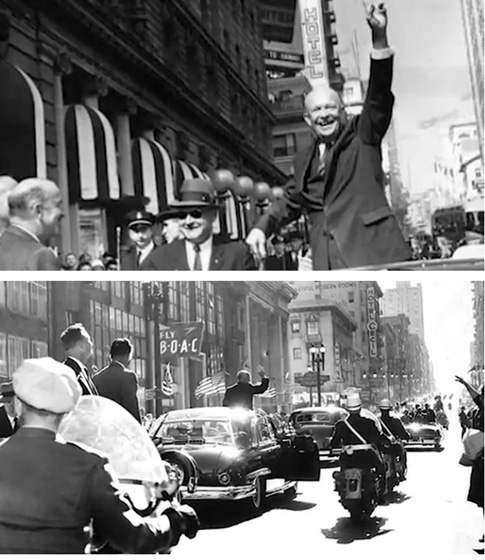
Is my understated sarcasm suggesting that Blaine's book may be less than 100% true? I'm pretty sure the story about JFK hitting Gerald on the head with a golf ball is true.
For a moment, consider the fact that Blaine's book which reads like a novel. The first sentence reads:
A the post outside the door to the Oval Office, Special Agent Jerry Blaine stood with his shoulders back, his ears tuned to pick up the slightest disruption, while subconsciously his elbow pressed loosely on the handle of the snub nose .38-caliber revolver strapped to his hip.He writes in the third person, giving the impression that someone else wrote it. Try writing about yourself in that manner. I can't do it myself. It feels like scratching on a blackboard.
[The Kennedy Detail, page 9]
Blaine's book has no footnotes, endnotes, links, references, documented quotes or any confirmations that what he writes is true. It's obvious that Blaine is not presenting his book as a scholarly work, but as biography of sorts. This is actually a great shame. Blaine obviously had a great number of inside contacts, people close to the action who would have felt more comfortable talking with Blaine than with a stranger. To not have all those discussions and interviews documented or recorded for the general public is a great loss.
Despite this, Blaine claims that his story IS true:
"What you are about to read is the true story of the events leading up to and following the assassination of President John F. Kennedy, from the perspective of the Secret Service agents who were there."Blaine includes a lot of quotes in his book, and at first I thought these were the actual words that people had spoken and that Blaine had some historical record of them, but I soon realized that for this to be the case, Blaine would need to have a remarkable memory to recall so accurately words that were spoken 50 years ago. For this reason, I tend to think that Blaine's quotes are just literary devices to make the story more readable. For example, I can't imagine why anyone would expect any of these quotes to be accurate:
[The Kennedy Detail, Prologue, page x]
"My initial goal in writing the story of the Kennedy Detail was to set history straight, to leave a book for my grandchildren that they could read and know was the truth beyond any measure of a doubt."
[The Kennedy Detail, Prologue, page xiii]
"It is only because of my complete faith and trust that Jerry would tell our story with dignity and unwavering honesty that I agreed to be involved."
[The Kennedy Detail, Forward by Clint Hill, page xv]
Blaine heard someone calling his name. "Blaine! Wait up!"Blaine's book apparently took five years to write, but six months before it was published, he gathered his old agent colleagues together for a reunion. While this was probably part of a marketing campaign for the book, he posted a picture of the reunion and said, "WE felt WE owed it to the public..," although I doubt he was sharing the royalties with anyone in that particular group
[The Kennedy Detail, page 16]
"Hey, Jer, I just wanted to give you heads-up for the schedule for the next two weeks," SAIC Behn said. "We're going to be busy."
[The Kennedy Detail, page 17]
"Okay. See you in a couple of weeks." Blaine gave a quick nod...
[The Kennedy Detail, page 20]
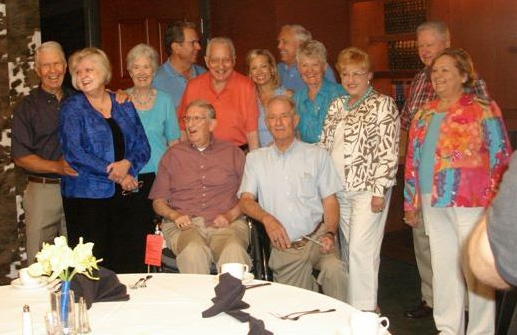
"Okay, it's time to contact the agents. Let's find out really what happened all the way through and communicate. We're the last of a dying breed. There aren't many of us left, so we felt we owed it to the public to give a balance to history."When Paul Landis was asked to contribute to the book, the book was only one week away from the deadline of the final script. For him it was a week of phone calls and emails. Sounds like whatever Landis's contribution was, it was after the book was already set in concrete. [YouTube Paul Landis - Cleveland, Ohio 31 May 2012 @ 23:40]
Gerald Blaine and Clint Hill on C-SPAN @ 03:40
So, let me re-cap:
Having the agents always on the rear bumper of JFK's limo was easier for the agents than riding the running boards on the follow-up car. The Secret Service made it clear that agents on the running board were much too far from the president. Both the advance men of the Tampa and Dallas motorcades wanted agents on the rear bumper of JFK's limo. The Secret Service has made it clear that the open windows in downtown Dallas was a problem and agents on the back of the car was the way to mitigate that danger.
Well except for any windows open on Elm Street. SA Clint Hill really didn't think agents on the back of the car was useful on the street where Kennedy was assassinated.
Gerald Blaine gave many loosely related reasons why Kennedy did not want agents riding the rear bumper steps: it would impede JFK from shaking hands, without it JFK could not get elected dog catcher, it would shield Kennedy from the public, agents on the back of the car are "excessive", it would give people the wrong impression, there was an election coming up, JFK would not be accessible to people, agents would obstruct people's view, the agents crowded JFK.
Does it seem plausible to you that a couple of guys standing on the back corners of an open-top car could impede the passenger's access to the public to such a degree?

But forgive me Gerald, I just can't see it.
I just can't see agents Lawton and Zboril on the rear of the limo as "excessive" or "crowding" or "giving the wrong impression." Nor can I see how Lawton and Zboril could prevent anyone from seeing JFK except for anyone in the follow-up car or maybe someone in the sixth floor window of the Texas School Book Depository.
Beating a Dead Horse
I could not write this little essay without reference to the work of Vince Palamara, the author of the recently published book Survivor's Guilt and numerous blogs. Vince's presence on the internet is large and all of his articles, blogs, monographs, on-line books are devoted to the Secret Service in relation to the assassination of JFK. Vince has said that his work was Blaine's inspiration for writing his book, The Kennedy Detail.
In Blaine and Clint Hill's 2010 interview on C-Span, they discuss Palamara for about five minutes starting at 17:18. Gerald takes direct aim at Vince, saying:
Mr. Palamara has ... no credibility. He's a self-described expert in his area. Which I don't know what it is. He was born after the assassination and he keeps creating solutions to the assassination until they're proven wrong.Clint Hill joins in with:
Clint Hill and Gerald Blaine on C-SPAN @ 20:30
In so far as him [Vince Palamara] being an expert, I don't know where the expert part came from. I spent a long time in the Secret Service in protection and I'm not an expert but apparently he became an expert somewhere up in Pennsylvania. I don't know where.Blaine refers to Palamara in his book, but rather sardonically as an "expert" [in quotes]:
Clint Hill and Gerald Blaine on C-SPAN @ 21:40
This same "expert" who had been interviewed for many conspiracy theory books relentlessly blamed the Secret Service for JFK's death by using their own statements against them. In many cases he called agents and recorded their conversations without their knowledge. When asked whether President Kennedy had ever ordered the agents off the back of his car, the agents gave him the standard line that Chief Rowley requested they give. And as the agents upheld their code, Rowley's words from the day of President Kennedy's funeral forever resonating in their minds, the Secret Service "expert" turned around and used their words to stab them - and their brothers - in the back with baseless accusations.In the C-SPAN interview, Blaine expands on CIA director Rowley's alleged desire to keep quiet about JFK's recklessness:
If these "experts" and "researchers" had only read some of the documents that were released in 1992 and are available online, they would have found a letter from Chief James J. Rowley written in response to J. Lee Rankin, general counsel of the Warren Commission, in which Rowley admitted what he so desperately did not want to become public. He did not want it to look as if the Secret Service was in any way blaming President Kennedy for his own death. He and every other member of the Kennedy Detail had accepted responsibility, and they would live with the grief and sense of failure for the rest of their lives.
[The Kennedy Detail, page 360 ]
"I always respected Jim Rowley because he stood up to the issue and said, "You can't say the president invited himself to be killed. So, let's squash this." So that was the word throughout the Secret Service. "The problem with Blaine's story that Rowley wanted to prevent any suggestion that JFK was to blame for his own death, is that Jim Rowley was the first to imply "the president invited himself to be killed."
Clint Hill and Gerald Blaine on C-SPAN @20:30
Jim Rowley wrote a Secret Service report dated December 18, 1963 in which he stated:
...the President had frequently stated that he did not wish to have the agents riding on these steps during a motorcade and had repeated this wish only a few days previously to agents assigned to him in Tampa.Rowley's Secret Service report became part of the Warren Commission Exhibits, which was released in the fall of 1964. Also in those exhibits was Clint Hill's testimony which also implied "the president invited himself to be killed." Gee, the cat was out of the bag from day one! Blaine has been beating a dead horse!
Report of the U.S. Secret Service on the Assassination of the President Kennedy - page 20
I'll include Hill's testimony too:
Mr. HILL. Yes, sir; there was. The preceding Monday, the President was on a trip in Tampa, Fla., and he requested that the agents not ride on either of those two steps.Emory Roberts, the guy who waved Don Lawton from the motorcade, wrote a memo dated seven days after the assassination. In that memo he states that the reason SA Ready stayed off the rear bumpers was because the motorcycles were in the way. Sounds a bit unlikely to me; it's not like the motorcycle was going to get in the agent's way or anything, or vice versa. At least Roberts didn't blame it on JFK.
Mr. SPECTER. And to whom did the President make that request?
Mr. HILL. Assistant Special Agent in Charge [Floyd] Boring.
Mr. SPECTER. And Special Agent Boring informed you of that instruction by President Kennedy?
Mr. HILL. Yes, sir; he did.
Mr. SPECTER. Did he make it a point to inform other special agents of that same instruction?
Mr. HILL. I believe that he did, sir.
Mr. SPECTER. And, as a result of what President Kennedy said to him, did he instruct you to observe that Presidential admonition?
Mr. HILL. Yes, sir.
Mr. SPECTER. How, if at all, did that instruction of President Kennedy affect your action and--your action in safeguarding him on this trip to Dallas?
Mr. HILL. We did not ride on the rear portions of the automobile. I did on those four occasions because the motorcycles had to drop back and there was no protection on the left-hand side of the car.
Clint Hill's Testimony to the Warren Commission: 2H132
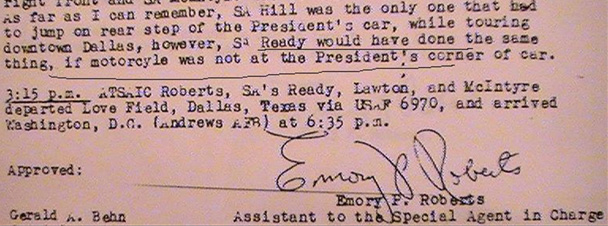
Emory P. Roberts, The White House Detail, Nov 29, 1963 VINCE PALAMARA'S MAIN SECRET SERVICE BLOG
"definitely on the back of the car for most of the day until they started back for MacDill AFB at the end of the day."Well, Tony was only 16 at the time. Just a kid. But how about Congressman Sam Gibbons, who was sitting in the back seat with JFK in Tampa? In this note to Palamara, Gibbons confirms Zappone's story:
MRS. KENNEDY & ME: A Very Good Book - a review by Vince Palamara
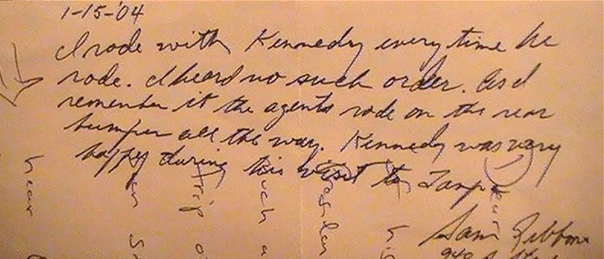
"I rode with Kennedy every time he rode [in the Tampa motorcade]. I heard no such order [to remove Agents from the rear bumper]. As I remember it the agents rode on the rear bumper all the way. Kennedy was very happy during his visit to Tampa.”
JFK in Tampa Florida 11/18/63- GERALD BLAINE & THE KENNEDY DETAIL DEBUNKED
The phrase "The Ivy League Charlatans" appears in 1967 in William Manchester's The Death of a President. The 781-page book was written at the request of Jacqueline Kennedy who, along with Robert Kennedy, had final authority over the script. Manchester conducted 1,000 interviews for the book and worked 100 hours a week for two years.
Palamara had this interesting factoid about Manchester:
Manchester even had early, exclusive access to the Warren Commission itself: "At the outset of my inquiry the late Chief Justice Earl Warren appointed me an ex officio member of his commission ... and provided me with an office in Washington's VFW building, where the commission met and where copies of reports and depositions were made available to me."Here is the passage in Manchester's work that has the words, "Ivy League charlatans":
[Survivor's Guilt, page 17]
It was a good idea, for example, to have agents perched on the broad trunk of the Presidential Lincoln when crowds threatened to grow disorderly. The trouble was that they were always there. Kennedy grew weary of seeing bodyguards roosting behind him every time he turned around, and in Tampa on November 18, just four days before his death, he dryly asked Agent Floyd Boring to "keep those Ivy League charlatans off the back of the car."So who gave Manchester the "Ivy League charlatan" quote? JFK supposedly spoke the phrase to Floyd Boring, sitting in front of him. Regarding interviews Palamara had with Floyd Boring and William Manchester, Palamara writes:
[The Death of a President, page 37]
Incredibly, Boring told this author, "I never told him [Manchester] that."Floyd Boring was interviewed in 1996 by Doug Horne of Assassination Records Review Board at the request of Palamara. Horne wrote:
As for the merit of the quote ["Ivy League charlatans"] itself ... Boring said, "No, no, no - that's not true,"
Boring expounded further: "Well that's not true. That's not true."
Incredibly, Boring was not even interviewed for Manchester's book! We may never know Mr. Manchester's source for this curious statement: he [Manchester] told the author on August 23, 1993 that "... all that material is under seal and won't be released in my lifetime" and denied the author access to his notes.
CTKA - The Good, the Bad, and the Ugly: A Review of The Kennedy Detail by Vince Palamara
"Mr. Boring was asked to read pages 136 - 137 of Clint Hill's Warren Commission testimony, in which Clint Hill recounted that Floyd Boring had told him just days prior to the assassination that during the President's Tampa trip on Monday, November 18, 1963, JFK had requested that agents not ride on the rear steps of the limousine, and that Boring had also so informed other agents of the White House detail, and that as a result, agents in Dallas (except Clint Hill, on brief occasions) did not ride on the rear steps of the limousine.What? No policy change? Just JFK's "kindness and consideration" in not wanting to stress agents out by forcing them to stand on the bumper? What happened to the reckless and narcissistic stand down order that JFK gave that got himself killed? No death by hubris or misadventure??
Mr. Boring affirmed that he did make these statements to Clint Hill, but stated that he was not relaying a policy change, but rather simply telling an anecdote about the President's kindness and consideration in Tampa in not wanting agents to have to ride on the rear of the Lincoln limousine when it was not necessary to do so because of a lack of crowds along the street."
CTKA - The Good, the Bad, and the Ugly: A Review of The Kennedy Detail by Vince Palamara
In a 'Fact Sheet' by Vince Palamara with a 1998 copyright, Palamara writes:
"President Kennedy did not instruct agents not to ride on the rear bumper of his car several days before Dallas." [The following agents and others] "collectively and in no uncertain terms, told me that President Kennedy never ordered the agents off the rear of his car...":SA Winston Lawson was in the Dallas motorcade, in the car ahead of JFK's limo. Lawson (who incidentally was at Gerald Blaine's June 2010 reunion) wrote a note to Vince Palamara dated January 12, 2004:
SAIC Gerald Behn - #1 man on JFK s detail
SAIC Robert Bouck - head of the Protective Research Section
ASAIC Floyd Boring - the #2 man on JFK s detail
ASAIC Arthur Godfrey - one of the three Shift Leaders on Kennedy's Texas trip
ASAIC Rufus Youngblood - on LBJ s detail on 11/22/63, riding in the V.P.'s car
ASAIC Maurice Martineau - the agent in charge of the Chicago office
SA Samuel Kinney - the driver of the Secret Service follow-up car in Dallas
SA Donald Lawton - who Emory Roberts waved off the running board at Love Field
SA Robert Lilley - a member of JFK's detail until one month before Dallas
SA Abraham Bolden - the first black member of the White House Detail
John Norris - a member of the Uniformed Division of the Secret Service, the White House Police
Dave Powers - Kennedy aide who rode with Kinney
Martin Underwood - DNC advance man for JFK's trip to Houston
Cecil Stoughton - White House photographer in the Dallas motorcade
"I do not know of any standing orders for the agents to stay off the back of the car."Palamara contacted former agent Arthur L. Godfrey of the White House Detail on May 30, 1996, regarding the notion that JFK ordered the agents not to do certain things which included removing themselves from the rear of the limousine:
[Survivor's Guilt, page 25]
"That's a bunch of baloney; that's not true. He never ordered us to do anything. He was a very nice man ... cooperative."Palamara also contacted Frank G. Stoner on January 17, 2004, and wrote this about him:
[Survivor's Guilt, page 27]
... former agent Stoner, who served in the Secret Service from January 1945 until 1969, said that Manchester was "probably trying to sell books" when he suggested that Kennedy ordered the agents off the back of the limousine. In fact, the 84-year-old former agent laughed at the mere suggestion. Stoner also agreed with several of his colleagues that JFK was "very personable": "He was an old Navy man. He understood security. He wouldn't have ordered them off the car."Maybe Don Lawton stood down from the Dallas motorcade with a big grin and three shrugs like it was no big deal, but I don't think so. I'm also pretty sure that, while JFK was concerned about appearance, it was not to the extent that Gerald Blaine claims. Regardless of what happened with Don Lawton or why no one was riding JFK's rear bumper, what the Secret Service actually did to protect the President was extremely limited. Their failure with the change in bumper protocol was only a part of the rather strange mismanagement of security that day. For example:
[Survivor's Guilt, page 36]
The Secret Service did not canvas buildings beforehand. They didn't insist windows along the motorcade route be closed. They didn't warn building owners how to handle strangers. They didn't scan the building roofs with a helicopter. They didn't use all the available manpower. [Nineteen on-duty Dallas Deputy Sheriffs listed in the Warren Commission Exhibits were close enough to the assassination to hear the gunshots of JFK's assassination, but not one of them was assigned to JFK's security.]
The Secret Service did not keep spectators off the bridge that the limo was going under at the end of Elm Street. They choose a dubious route to the Trade Mart (going down Elm Street) when an alternate, safer route was just just as direct. The Secret Service agents said they were scanning the windows of buildings yet not one of the 16 agents in the motorcade saw what a number of untrained witnesses in a sparse crowd saw: a gun barrel sticking out the window in the TSBD.
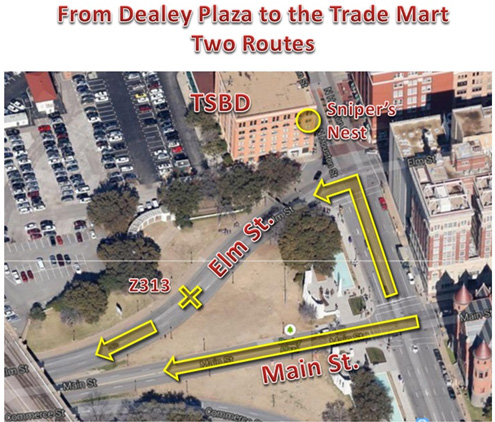
They could have just as easily continued straight on Main Street.
When shots rang out agents assumed the noise was something else (backfire, or fire crackers). When shots rang out, no one ran to the aide of JFK. When shots rang out, Emory Roberts may have restrained the agents on the running board from acting. When shots rang out, the limo driver, Bill Greer, toes the brake pedal rather than the accelerator, and does not respond to the agent in charge sitting next to him.
Why would the Secret Service change a standard and simple protocol (the riding of an agent on the rear bumper) that would significantly reduce the president's already flimsy protection?
Blaine described JFK as warm and fuzzy, always wanting to shake someone's hand: "he [JFK] would stop by the post and shoot the breeze..." Did members of the Secret Service really have such a fear of JFK that they could not insist on two guys riding the bumper in the motorcade? Or at least discuss it with him?
Unlike Clint Hill's 1975 60 Minute interview where Clint shows some remorse, Blaine's book The Kennedy Detail does everything it can to shirk all responsibility. In considering motives, Blaine's work may be motivated by a desire to resolve years of (what he sees as) abuse by JFK researchers and to shed whatever guilt the agents of the Secret Service may have had over the decades.
On the other hand, Blaine's work attempts to deflects any idea of a conspiracy around the death of JFK. One day agents are riding the bumper, four days later the policy changes and JFK is dead.
"Conspiracy theory has become a 'Cottage Industry', yet after 47 years there is not one solid piece of evidence that a conspiracy existed."Not one solid piece of evidence that a conspiracy existed? What we do have are a thousand shards of evidence that collectively imply with great certainty that the Warren Commission's findings are hopelessly flawed. This change in protocol on bumper riding is only one shard.
Gerald Blaine in the Miami New Times
It is not my intention to embarrass the Secret Service or add to their collective guilt. Agents have suffered enough in that respect, I'm sure. But Gerald Blaine is spinning the false reality of a fairy tale world: the assassination of a second-rate president by a lone-nut. Gerald does us all a great disfavor. The assassination of JFK is a tragedy of epic proportions and Gerald's work only adds to our collective grief.
Gerald Blaine claims he speaks for all former Secret Service agents, but he does not speak for former agent Abraham Bolden. Blaine takes steps to discredit him by pointing out that Bolden is a convicted felon and his "incredulous" claim of an attempt to assassinate JFK in Chicago just three weeks prior to Dallas. However, Bolden says he was framed and I find the Chicago assassination plot entirely credible. Abraham Bolden writes about Blaine's book:
I just finished reading the 448 page "Cover Your Ass" book by agent Blaine. As a former Secret Service Agent and the first African American to be appointed to the White House Detail, I was dismayed at the continued attempts by former agents to deny culpability in the assassination of President John F. Kennedy. ...I was hoping that the former Kennedy body guards would show a modicum of contriteness in the book instead of trying to blame Kennedy's assassination on the President himself. ...I was an agent during the critical period on November 22, 1963. In my book, "The Echo from Dealey Plaza", I relate ... the disrespect and hatred towards the President that I heard expressed by some of my fellow agents.
Amazon.com Reviews Written by Fmr. Agent Abraham Bolden
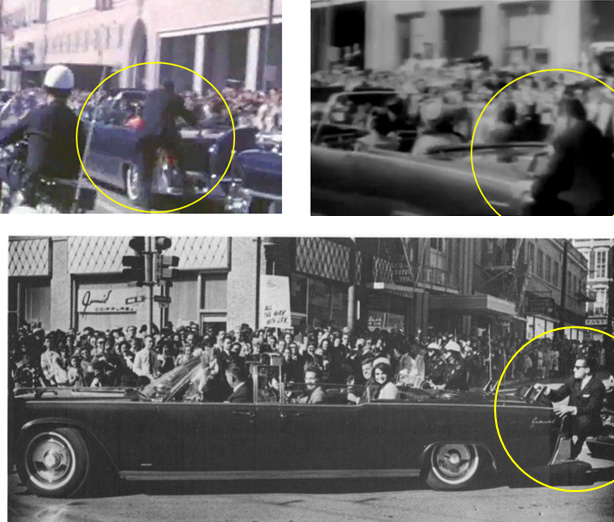
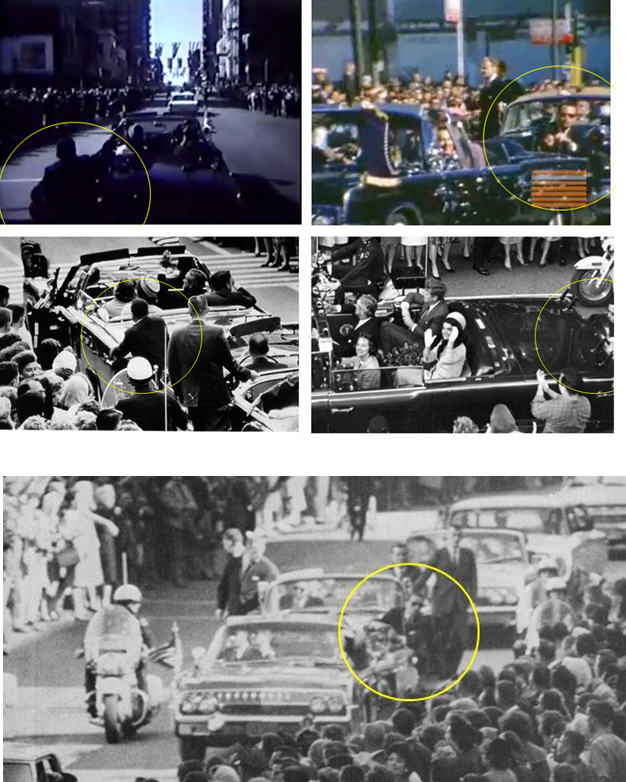
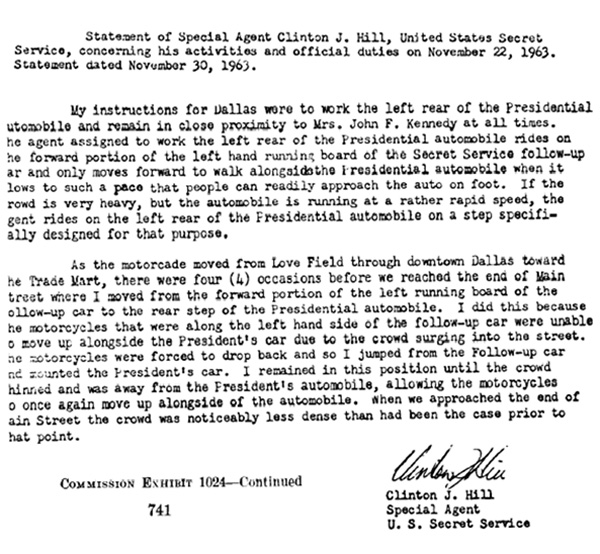
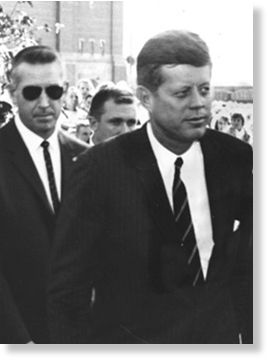
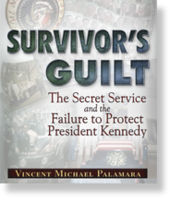
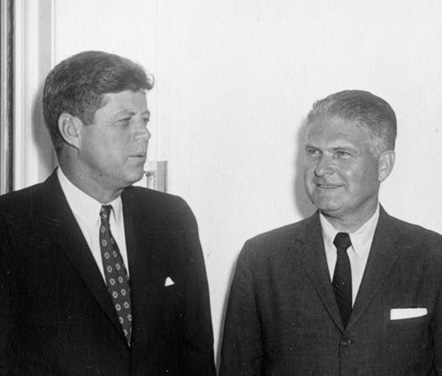
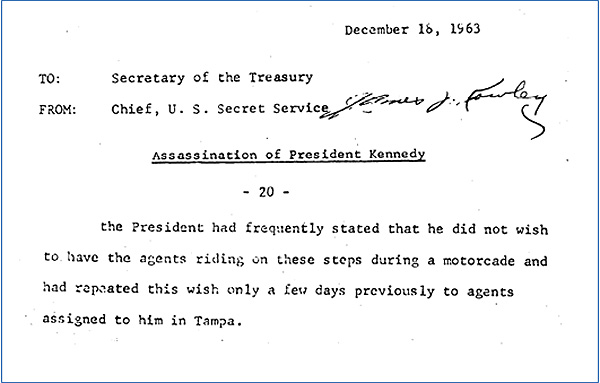
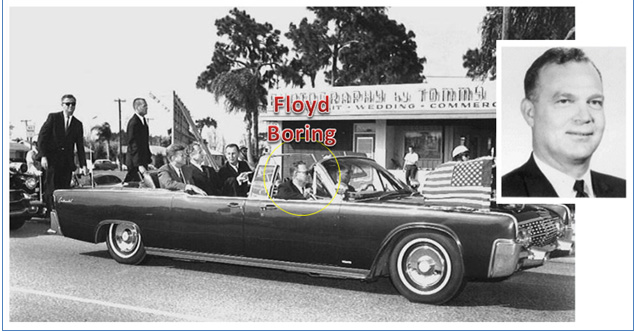



it's a mute point after-the-fact, as the winners rewrite the history and keep the lies coming from cradle to grave. Any smart assassination(physical or public) will utilize the proclivities of their target in question, as that path is already grooved and easier to exploit. In a 'kill or be killed' situation, it's always best to know the game you find yourself playing, and this one requires you to make the first and last move, lest you give your opponent that same opportunity. You opponent understands this already and is prepared to act accordingly, are you?
This scenario again sounds like Caesar letting his bodyguards behind when entering the Forum. No weapon check at the entrance etc. If you know 'they' are coming to 'get' you, it's best to have the terrain prepared for a trap, because they have theirs already planned, it's just a question of who executes their policy first. This awareness didn't seem present in the Kennedy camp until it was too late, way too late, just ask Bobby or all those other 100 or so witnesses: www.sott.net/article/268940-Disappearing-witnesses-Over-100-murders-suicides-and-mysterious-deaths-the-strange-fate-of-those-who-saw-Kennedy-shot